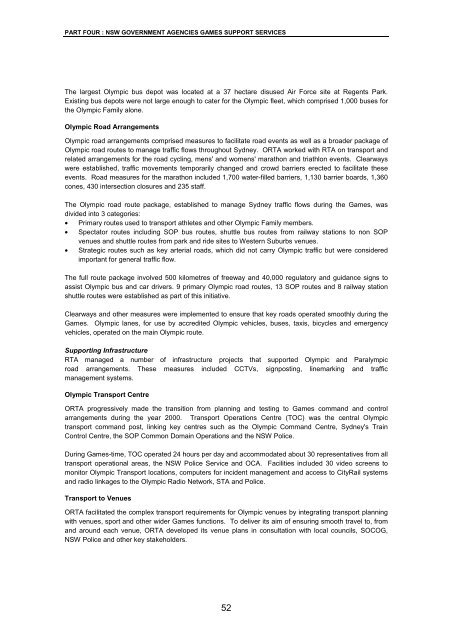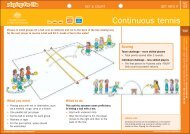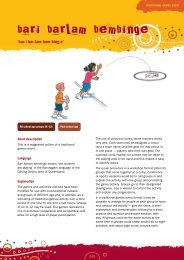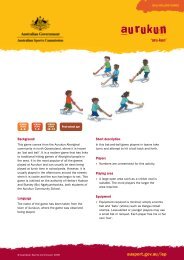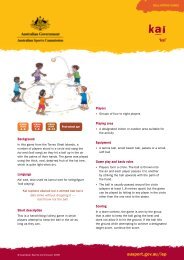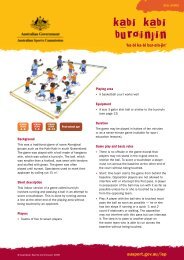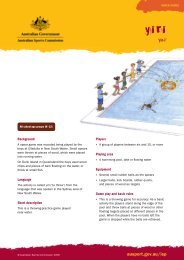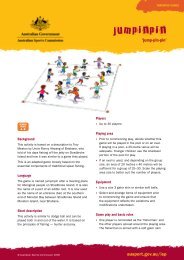the sydney 2000 olympic and paralympic games - Australian Sports ...
the sydney 2000 olympic and paralympic games - Australian Sports ...
the sydney 2000 olympic and paralympic games - Australian Sports ...
You also want an ePaper? Increase the reach of your titles
YUMPU automatically turns print PDFs into web optimized ePapers that Google loves.
PART FOUR : NSW GOVERNMENT AGENCIES GAMES SUPPORT SERVICES<br />
The largest Olympic bus depot was located at a 37 hectare disused Air Force site at Regents Park.<br />
Existing bus depots were not large enough to cater for <strong>the</strong> Olympic fleet, which comprised 1,000 buses for<br />
<strong>the</strong> Olympic Family alone.<br />
Olympic Road Arrangements<br />
Olympic road arrangements comprised measures to facilitate road events as well as a broader package of<br />
Olympic road routes to manage traffic flows throughout Sydney. ORTA worked with RTA on transport <strong>and</strong><br />
related arrangements for <strong>the</strong> road cycling, mens' <strong>and</strong> womens' marathon <strong>and</strong> triathlon events. Clearways<br />
were established, traffic movements temporarily changed <strong>and</strong> crowd barriers erected to facilitate <strong>the</strong>se<br />
events. Road measures for <strong>the</strong> marathon included 1,700 water-filled barriers, 1,130 barrier boards, 1,360<br />
cones, 430 intersection closures <strong>and</strong> 235 staff.<br />
The Olympic road route package, established to manage Sydney traffic flows during <strong>the</strong> Games, was<br />
divided into 3 categories:<br />
• Primary routes used to transport athletes <strong>and</strong> o<strong>the</strong>r Olympic Family members.<br />
• Spectator routes including SOP bus routes, shuttle bus routes from railway stations to non SOP<br />
venues <strong>and</strong> shuttle routes from park <strong>and</strong> ride sites to Western Suburbs venues.<br />
• Strategic routes such as key arterial roads, which did not carry Olympic traffic but were considered<br />
important for general traffic flow.<br />
The full route package involved 500 kilometres of freeway <strong>and</strong> 40,000 regulatory <strong>and</strong> guidance signs to<br />
assist Olympic bus <strong>and</strong> car drivers. 9 primary Olympic road routes, 13 SOP routes <strong>and</strong> 8 railway station<br />
shuttle routes were established as part of this initiative.<br />
Clearways <strong>and</strong> o<strong>the</strong>r measures were implemented to ensure that key roads operated smoothly during <strong>the</strong><br />
Games. Olympic lanes, for use by accredited Olympic vehicles, buses, taxis, bicycles <strong>and</strong> emergency<br />
vehicles, operated on <strong>the</strong> main Olympic route.<br />
Supporting Infrastructure<br />
RTA managed a number of infrastructure projects that supported Olympic <strong>and</strong> Paralympic<br />
road arrangements. These measures included CCTVs, signposting, linemarking <strong>and</strong> traffic<br />
management systems.<br />
Olympic Transport Centre<br />
ORTA progressively made <strong>the</strong> transition from planning <strong>and</strong> testing to Games comm<strong>and</strong> <strong>and</strong> control<br />
arrangements during <strong>the</strong> year <strong>2000</strong>. Transport Operations Centre (TOC) was <strong>the</strong> central Olympic<br />
transport comm<strong>and</strong> post, linking key centres such as <strong>the</strong> Olympic Comm<strong>and</strong> Centre, Sydney's Train<br />
Control Centre, <strong>the</strong> SOP Common Domain Operations <strong>and</strong> <strong>the</strong> NSW Police.<br />
During Games-time, TOC operated 24 hours per day <strong>and</strong> accommodated about 30 representatives from all<br />
transport operational areas, <strong>the</strong> NSW Police Service <strong>and</strong> OCA. Facilities included 30 video screens to<br />
monitor Olympic Transport locations, computers for incident management <strong>and</strong> access to CityRail systems<br />
<strong>and</strong> radio linkages to <strong>the</strong> Olympic Radio Network, STA <strong>and</strong> Police.<br />
Transport to Venues<br />
ORTA facilitated <strong>the</strong> complex transport requirements for Olympic venues by integrating transport planning<br />
with venues, sport <strong>and</strong> o<strong>the</strong>r wider Games functions. To deliver its aim of ensuring smooth travel to, from<br />
<strong>and</strong> around each venue, ORTA developed its venue plans in consultation with local councils, SOCOG,<br />
NSW Police <strong>and</strong> o<strong>the</strong>r key stakeholders.<br />
52


